The lack of mass is due primarily to the use of Grilamid® on the lower shell, and to a lesser extent the use of magnesium in the metal components of the buckles. Garmont first experimented with Grilamid® on their Masterlite boot series. Grilamid® is a nylon based plastic that is 5% lighter than Pebax, but stiffer, and maintains its relative stiffness over temperature unlike polyurethane shells. To maintain structural integrity while minimizing material Garmont adopted the same Webframe technology used in the Masterlite series to reduce weight but not performance.
Fit
Buckles
A important ingredient in the fit factor was the placement of the buckle over the in-step. Ordinarily I need to fill the space between the liner and the shell of any Garmont boot with a thick hunk of foam to keep my heel anchored in the shell. Not so this time. Since I have a low in-step this suggests that those of you with a tall in-step may find these too tight. However, when I tested the Cosmos with a group of a dozen other writers everyone agreed the fit was amazing, so my caveat may be meaningless.
The buckles on the cuff have a wire cover over the teeth so that once the hook is set in a particular tooth it stays there when you flip the buckle open for skinning. The wire catch is simple and reliable, but not as clean as the EZ Lock buckles found on the previous generation of Garmont boots, like the Radium. I’m guessing the switch in buckle style was made to save a few bucks, and though they work, they’re just not as nice as the EZ Lock version with the rib of plastic inside the grooves to catch the wire latch. They do remain micro adjustable though.
Walking Comfort
When the cuff lock switch is flipped to walk mode the Cosmos becomes a dream machine for walking on a dry trail, skinning across a long flat plateau, or up a hundred switchbacks. The reason is the cuffs relatively frictionless 60° range of motion. Keep in mind when your foot is in the boot you won’t experience anything close to a 60° range of motion but all that really matters is how far back from vertical you can flex your foot. With my foot in the boot, and the buckles opened on the loosest tooth I had about 12° movement to the rear – it felt like 20° – and there was still plenty of room for the cuff to open up even further. As with other boots in this new genre of ultra flexible cuffs the actual range of motion will depend on how much you loosen the power strap and cuff buckles.
In the case of the Cosmos, and the entire Powerlite series, the important thing to remember is that Garmont has taken pains to eliminate as much rotational friction in the cuff as possible. This is done primarily with a patent pending mode switch that doesn’t just retract the pin holding it locked for skin mode, but it opens the latch like a garage door to eliminate any contact with the heel post that it slides along. Without any binding friction from the latch the cuff moves easier, and further aft, yielding more rear range of motion of your lower leg, with less rotational resistance.The bottom of the boot has Vibram ® soles for good grip when scrambling on rock and the sole is rockered up a few degrees at the toe to give a more natural stride that rolls off the toe when hiking. When you combine the cuff freedom, lightweight and rockered sole, like I said above, they’re a dream to walk or break trail in. Color me impatient to see this cuff design incorporated in Garmont’s tele line.
Ski Performance
So how do they ski? According to Paul Parker, Garmont’s product manager for boots they ski as good as the Radium which is probably true for him. Whether that translates for mere mortals will be something to be deducted after word filters out from real customers. As a part time AT skier they felt solid for a mid-sized, mid-stiff boot with tech-fittings. If you need power on steroids to hammer bumps and land air you probably want a bigger boot. For realistically sized backcountry skis though, say up to 115mm underfoot, the Cosmos provides plenty of turning power. It offers two different forward lean positions – but you’ll need an allen wrench to switch between 11.5° and the more aggressive 13° position. An asymmetric spoiler has been added at the back of the cuff for more lateral control and to finish off the system the power strap is elasticized and wide, adding a bit of turbo charged power transfer from your lower leg to the boot.
Conclusion
If you’re earning your turns in the backcountry, any of the boots in Garmont’s PowerLite series should be on your short list for consideration with fit being the final deciding factor.
Garmont
MSRP: $699
Weight/boot: 3 lbs., 3 oz. (1450 g) sz 27.5 mondo
Sizes available (mondo): 25.0—31.5
Last width (sz 27.5): 103.5mm
Forward Lean: 11° & 13.5°
Celeste (women’s version)
MSRP: $699
Sizes available (mondo): 23.0—27.5
Last width (sz 27.5): 103.5mm
Forward Lean: 11° & 13.5°
Related Posts:
Preview: Garmont’s PowerLite Series AT Boots
© 2012

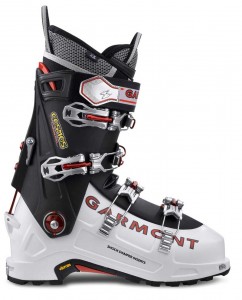
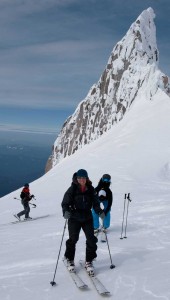
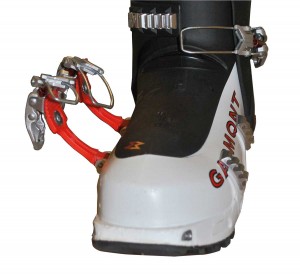
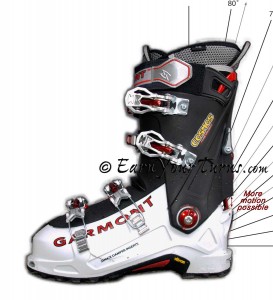
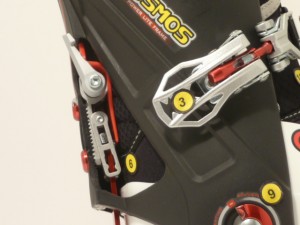
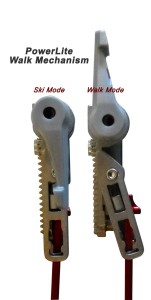
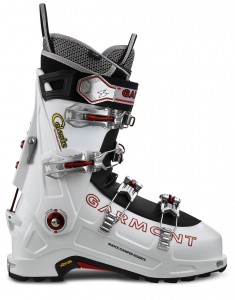
1 comment
Nice! Sizing avail up to a 31.5 with a reasonably wide forefoot, thank you Garmont!